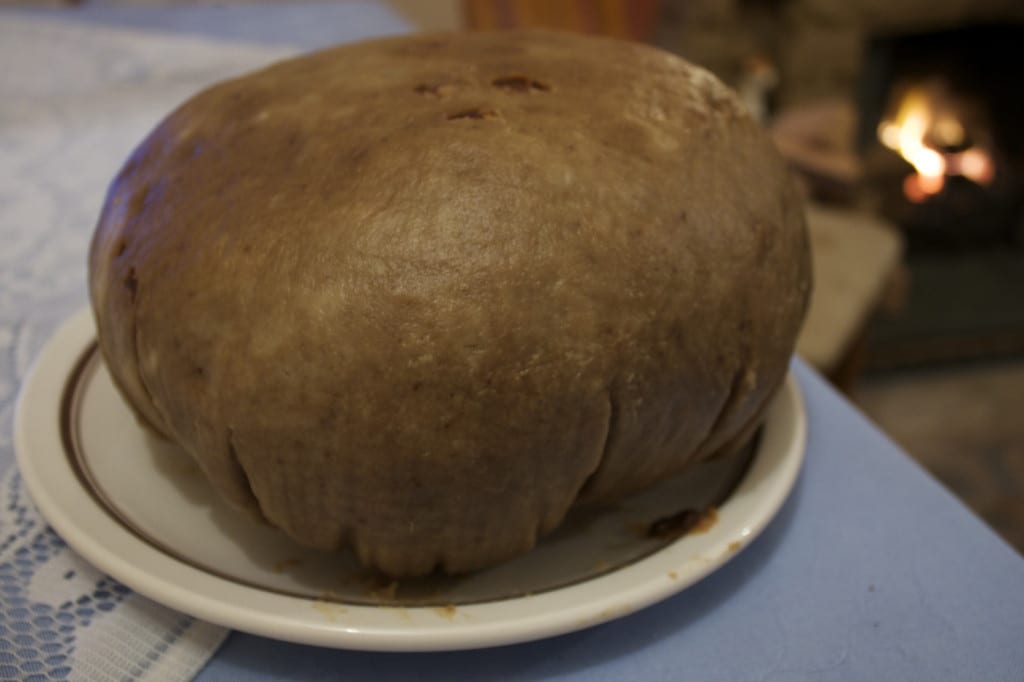When discussing Scottish food, most people will have heard of haggis, neeps and tatties or know about Arbroath Smokies and shortbread but how many will have heard of Crappit Heid, Festy cock or Clapshot?
With that in mind we scoured the land and found eight of the weirdest names for Scottish foods:

Clootie Dumpling. Picture: Wikimedia
Clootie dumpling is a rich, suet-based fruit pudding. Ground ginger, cinnamon and other spices find their way into the mix, alongside raisins, sultanas and other dried fruits.
Recipes vary from region to region, but the pudding is generally served with whisky and clotted cream. The word clootie refers to the cloth that the dessert is cooked in. A Clootie Dumpling World Championship is held every year in Avonbridge, of which 87-year-old Ruth Brown is the current holder.
Described in some circles as fish haggis, Crappit heid is the hollowed-out head of a 20lb cod, washed and de-scaled, it is then rammed full with fistfuls of oats, suet, onions and white pepper. The head is then sewn shut and finally boiled in seawater for extra flavour.
The dish can be traced back to 18th-Century coastal communities around Aberdeenshire, where poor fishermen’s families survived on this style of meal after being forced to sell the more expensive fillets of fish when money was tight. Crappit heid was a favourite midday or evening meal amongst these fishing communities and would be served with potatoes or other seasonal root vegetables.
This delicious dessert is a definite must try for those who haven't had the pleasure of tasting it. Usually reserved for Burns night, Cranachan is made using whipped cream (or crowdie if you want to be truly authentic), honey, fresh raspberries, and toasted oatmeal usually soaked overnight in a little bit of whisky. More whisky is added to the finished product which is then put in dessert glasses to be served.
A legacy of the French influence on Scottish cuisine, A “howtowdie” is typically described as a young hen, and is likely derived from the Old French word, “hétoudeau”, meaning pullet or capon. The chicken is traditionally stuffed with skirlie (oats), cooked and is then usually served with drappit (dropped or poached) eggs and spinach.
A traditional accompaniment to Haggis, Clapshot is achieved by mixing mashings of swede turnips and potatoes, with chives and butter, and seasoning to taste. Originating in Orkney, Clapshot is a wonderfully filling side to any traditional meat dish.
Despite what results may come up when you search for this on the internet, no, this is not an annoying person at a music festival. It is actually a Scottish alternative to the pancake, made from fine-ground oatmeal mixed with a small amount of water, rolled, flattened and usually folded into a rough bird shape. These pancakes were then fired in a kiln and then eaten to mark Shrove Tuesday.
The word festy is thought to refer to Festern's E'en, the day before Shrove Tuesday, when cock fighting usually took place, this cruel sport was associated with the driving out of evil and violence before Lent.
Perhaps the best named dish on this list, Rumbledethumps (try saying that with a mouth full of crappit heid) originated in the Scottish Borders and is closely related to the similarly oddly named Bubble and Squeak, which is popular in England. Made using potato, cabbage and onion, the ingredients are mashed up and placed in a pot, with a layer of cheese added before cooking.
The wonderfully named Tipsy Laird, is not, as it sounds, a drunken aristocrat or a particularly difficult yoga manoeuvre but rather a delightful, traditional dessert that usually rounds off a rousing Burns supper. It is essentially a Scottish twist on a trifle using Scottish raspberries and whisky instead of sherry.
